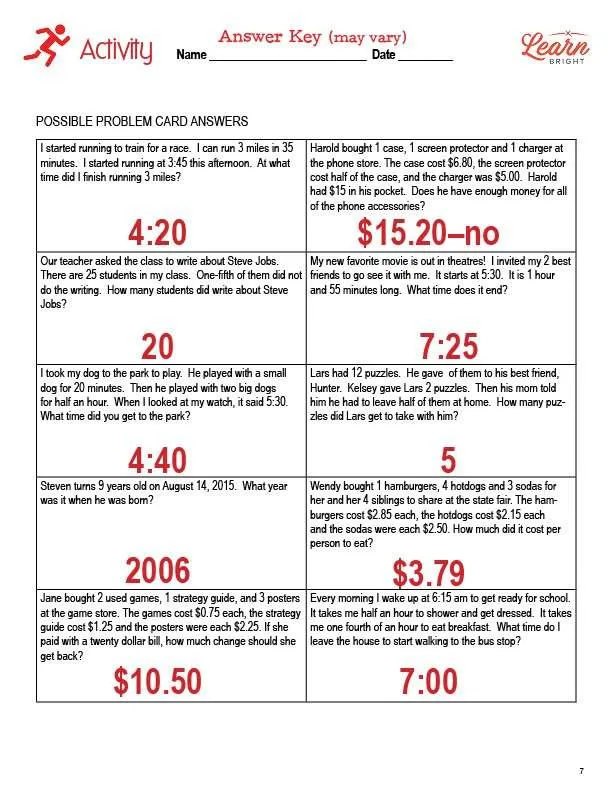Description
What our Measurement Word Problems lesson plan includes
Lesson Objectives and Overview: Measurement Word Problems teaches students how to solve word problems with whole numbers, fractions, and decimals. Students will use one of five strategies that the lesson describes. These strategies are question, information, clue words, create an equation, and check your work. By the end, they will be able to solve word problems involving money, time, length, and other units. This lesson is for students in 4th grade, 5th grade, and 6th grade.
Classroom Procedure
Every lesson plan provides you with a classroom procedure page that outlines a step-by-step guide to follow. You do not have to follow the guide exactly. The guide helps you organize the lesson and details when to hand out worksheets. It also lists information in the blue box that you might find useful. You will find the lesson objectives, state standards, and number of class sessions the lesson should take to complete in this area. In addition, it describes the supplies you will need as well as what and how you need to prepare beforehand.
Options for Lesson
Included with this lesson is an “Options for Lesson” section that lists a number of suggestions for activities to add to the lesson or substitutions for the ones already in the lesson. One optional addition to the lesson activity is to have your students make posters in groups with the word problems to show two strategies for solving the problems. You could also have your students solve one problem and then check with the teacher for completion, earning a sticker for each correct word problem. Finally, you could have your students design a word problem on their own and compile them to create a packet of problems from the class.
Teacher Notes
The teacher notes page includes lines that you can use to add your own notes as you’re preparing for this lesson.
MEASUREMENT WORD PROBLEMS LESSON PLAN CONTENT PAGES
Measurement Word Problems
The Measurement Word Problems lesson plan includes two content pages. We solve word problems every day without even realizing it, like when we find distances, calculate intervals of time, determine amounts such as volume and mass, and find answers to how much money we save and spend. A lot of these problems include fractions or decimals in addition to whole numbers.
It can feel overwhelming to try to solve a word problem, but we have strategies that we can use to help make it easier. For all word problems, you can follow five simple steps to solve them: 1. Question, 2. Information, 3. Clue Words, 4. Create an equation, and 5. Check your work.
Example Problem: Steps 1—3
Let’s look at an example problem and solve it using the five steps listed above. The example problem is: Suki loves the fall and goes to a pumpkin patch each year. This year she brings Julie, her best friend. They each pick out a pumpkin. Suki’s pumpkin weighs 6,000 grams. Julie’s pumpkin weighs 5.5 kilograms. What is the difference in the weight of the pumpkins?
The first step is Question! First, read the whole problem without writing anything down or trying to solve it right away. Next, read it again to determine what question you need to answer. For the example, we’re trying to find the difference between the pumpkins.
The second step is Information. Now that we know the question, we need to find the information that we need to solve that question. You might want to highlight key words and phrases. For the example, we’ll highlight that Suki’s pumpkin is 6,000 grams and Julie’s pumpkin is 5.5 kilograms, which is equal to 5,500 grams.
The third step is Clue Words. We need to find the words in the problem that will help us determine which operation or operations (addition, subtraction, multiplication, or division) we need to use to solve the question. For the example, the problem includes the word difference. This tells us that we will be using subtraction.
Key words that indicate addition include combined, increased, total of, sum, added to, together, plus; for subtraction, they include minus, less than, less, fewer than, difference, decreased, take away, more than; for multiplication, they include multiplied, product of, times, of; and for division, they include divided by, into, per, quotient of, percent, out of, ratio of.
Example Problem: Steps 4—5
The fourth step is Solve (or Create an equation). We need to create an equation or expression to help us solve the question. The equation for the example is 6,000 – 5,500 = 500 grams difference.
Visualizing the problem can also be helpful during this step. If you’re working with smaller numbers, try drawing a picture or using manipulatives. If you’re working with larger number, try drawing a diagram or chart. You can also use number lines or line plots!
Finally, the fifth step is Check your work. The first question to ask yourself during this step is, “Does my answer make sense?”. If it doesn’t, go back and rework the problem. If it does, work backwards to plug in your solution and double-check it. For the example, our answer does make sense, because 500 grams is a normal difference in pumpkin weight.
The lesson closes with an additional example, walking through each of the five steps. Students should read through this example as well to make sure they understand each step. If they do, they can use the steps to help solve any word problems they come across!
MEASUREMENT WORD PROBLEMS LESSON PLAN WORKSHEETS
The Measurement Word Problems lesson plan includes four worksheets: an activity worksheet, a practice worksheet, a homework assignment, and a quiz. You can refer to the guide on the classroom procedure page to determine when to hand out each worksheet.
PROBLEM CARDS ACTIVITY
The activity worksheet has two pages, one with a blank table with 10 boxes and one with 10 word problems. Students will cut out the word problem cards and pick out several to solve. They will use the blank boxes to show their work and display which strategy they used.
SOLVE THE PROBLEMS PRACTICE WORKSHEET
There are two word problems on the practice worksheet. The word problems contain a lot of information, and students will have to determine which parts are important to solving the problem. There are two questions to answer for each word problem.
STATE PARK WORD PROBLEM HOMEWORK ASSIGNMENT
The homework assignment requires students to answer three questions that all relate to the same word problem.
MEASUREMENT WORD PROBLEMS QUIZ
Similar to the homework worksheet, students will solve a single word problem through several questions. Then they will solve a final word problem that relates to the information they learned in the first problem.
Worksheet Answer Keys
This lesson plan includes answer keys for the activity worksheet, the practice worksheet, the homework assignment, and the quiz. If you choose to administer the lesson pages to your students via PDF, you will need to save a new file that omits these pages. Otherwise, you can simply print out the applicable pages and keep these as reference for yourself when grading assignments.









